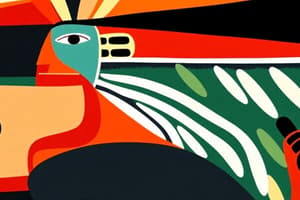Podcast
Questions and Answers
What significant role did Jigonhsasee play in the formation of the Confederacy?
What significant role did Jigonhsasee play in the formation of the Confederacy?
Jigonhsasee played a crucial role in the formation of the Confederacy.
What form of governance did Athens adopt around 508 BC?
What form of governance did Athens adopt around 508 BC?
Democracy
What was the primary method of voting in Athenian Democracy?
What was the primary method of voting in Athenian Democracy?
Placing pebbles in vases
Who was excluded from voting in Athenian Democracy?
Who was excluded from voting in Athenian Democracy?
What was the primary purpose of the Boule in Athenian Democracy?
What was the primary purpose of the Boule in Athenian Democracy?
What was the significance of the geographic location of Greece?
What was the significance of the geographic location of Greece?
What was the primary role of women in Athenian society?
What was the primary role of women in Athenian society?
What was the primary role of slaves in Athenian society?
What was the primary role of slaves in Athenian society?
What year did the Tuscarora nation join the Iroquois Confederacy?
What year did the Tuscarora nation join the Iroquois Confederacy?
What was the main goal of the Iroquois Confederacy?
What was the main goal of the Iroquois Confederacy?
What was the significance of the Onondaga nation in the Iroquois Confederacy?
What was the significance of the Onondaga nation in the Iroquois Confederacy?
What was the impact of the American Revolutionary War on the Iroquois Confederacy?
What was the impact of the American Revolutionary War on the Iroquois Confederacy?
What is the significance of wampum belts in the Iroquois Confederacy?
What is the significance of wampum belts in the Iroquois Confederacy?
What is the role of Clan Mothers in Haudenosaunee society?
What is the role of Clan Mothers in Haudenosaunee society?
What is the significance of the Seneca nation in the Iroquois Confederacy?
What is the significance of the Seneca nation in the Iroquois Confederacy?
What is the characteristic of the Iroquois Confederacy's system of governance?
What is the characteristic of the Iroquois Confederacy's system of governance?
Flashcards are hidden until you start studying
Study Notes
Iroquois Confederacy
- Formed around 1570, consisting of the Mohawk, Oneida, Seneca, Onondaga, and Cayuga nations.
- Later expanded with the addition of the Tuscarora in 1722.
- Aimed at maintaining peace and mutual protection from European and other nation attacks.
Geographic Distribution
- Traditional lands mainly located in present-day United States, with some territories extending into Canada.
- Maps illustrate territorial changes over time due to conflicts and treaties.
Impact of the Revolutionary War
- Many indigenous peoples, including the Iroquois, were displaced following their alliance with the British during the American Revolutionary War.
- Forced migrations northward to Canadian territories occurred.
Overview of Nations within the Confederacy
- Seneca: Largest and westernmost, skilled in war and diplomacy.
- Cayuga: Centered around Cayuga Lake, divided into five clans.
- Onondaga: Central and known as "Keepers of the Fire," central in mediation and record-keeping.
- Oneida: Spread across modern-day New York, known for three clans and forced displacement post-Revolutionary War.
- Mohawk: Easternmost, guarding the eastern entrance to the Confederacy.
- Tuscarora: Latest addition, originally from North Carolina, joined in 1722 with Oneida sponsorship.
Governance and Constitution
- Governed by the Great Law of Peace, an oral constitution detailing council functions, rights, and responsibilities.
- Symbolized through wampum belts, containing intricate designs representing key aspects of Haudenosaunee history and traditions.
Women in Haudenosaunee Society
- Haudenosaunee society is matriarchal, with women holding significant power.
- Role of Clan Mothers pivotal in governance, including the selection and removal of chiefs.
- Matrilineal descent and responsibilities in food production, clothing, and household affairs highlight women's central role.
Cultural Practices
- Use of wampum in communication and ceremonial contexts, emphasizing truth and attention during meetings.
- Historical figures like Jigonhsasee played crucial roles in the formation of the Confederacy.
Athenian Democracy
- Emerged in Athens around 508 BC, emphasizing "people power."
- Key governmental bodies: the Ecclesia (assembly), the Boule (council), and the courts.
Geographic and Historical Context
- Greece, a peninsula surrounded by water, features mountainous landscapes and islands.
- Major events in Greek history include the Minoan and Mycenaean civilizations, the Trojan War, and the rise of democracy.
Forms of Government
- Monarchy: Ruled by a single power or tyrant.
- Oligarchy: Governed by a small group of wealthy citizens.
- Democracy: Power vested in the people, with elected officials and citizen participation.
Democratic Processes
- Voting: Citizens participated in decision-making through methods like placing pebbles in vases.
- Eligibility: Only male citizens who met specific criteria could vote, excluding women, slaves, and foreigners.
Criticisms and Inequalities
- Limited Participation: Despite democratic principles, only a small portion of the population had a say in government.
- Role of Women: Women lacked political rights and were confined to domestic roles.
- Role of Slaves: Enslaved individuals performed laborious tasks and had minimal rights.
- Role of Children: Education and societal roles varied by gender, with boys receiving formal education and military training.
Studying That Suits You
Use AI to generate personalized quizzes and flashcards to suit your learning preferences.




